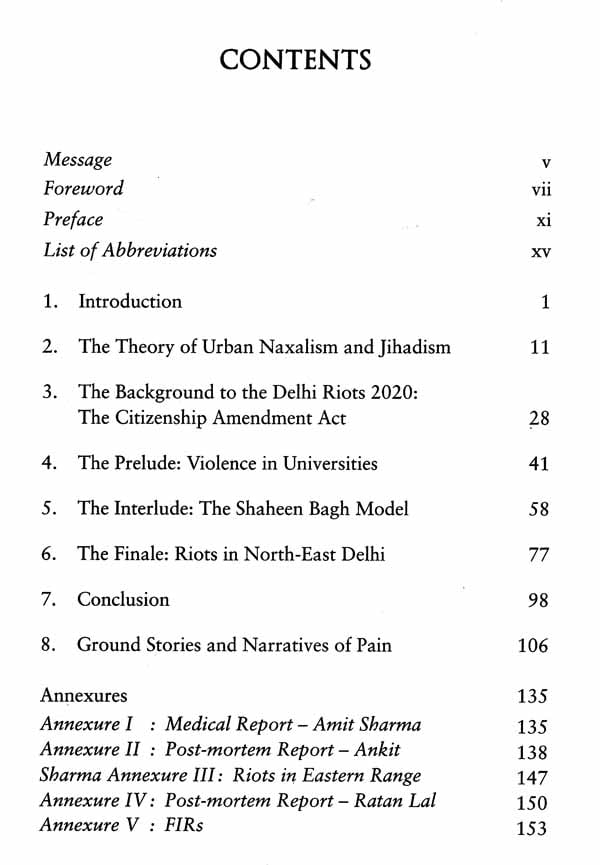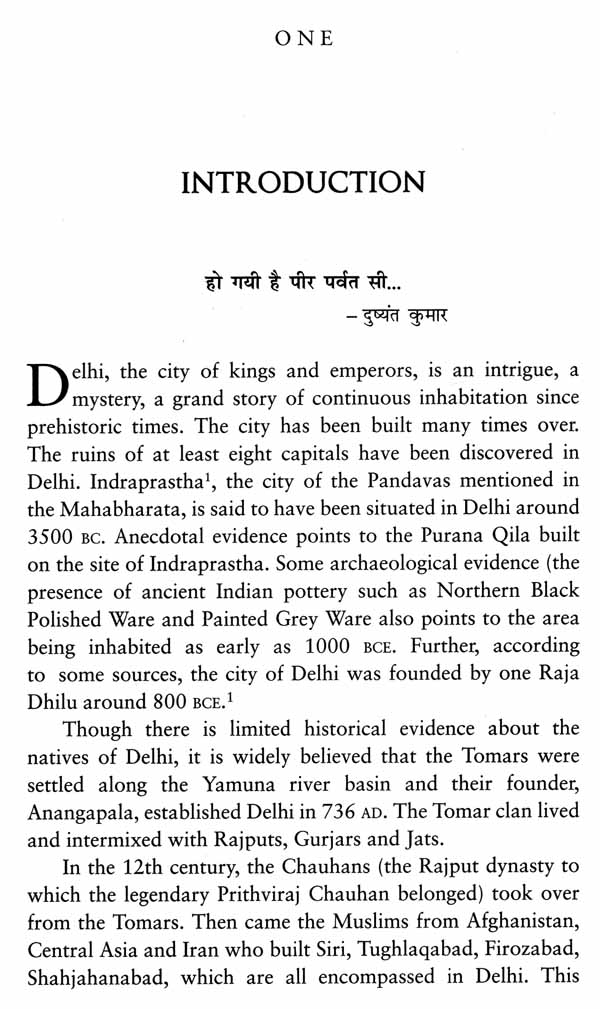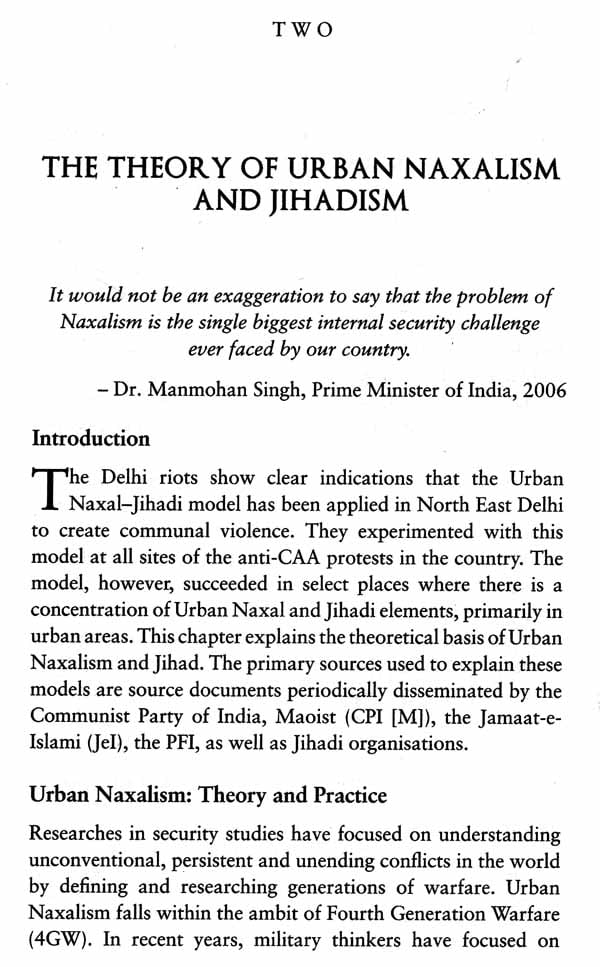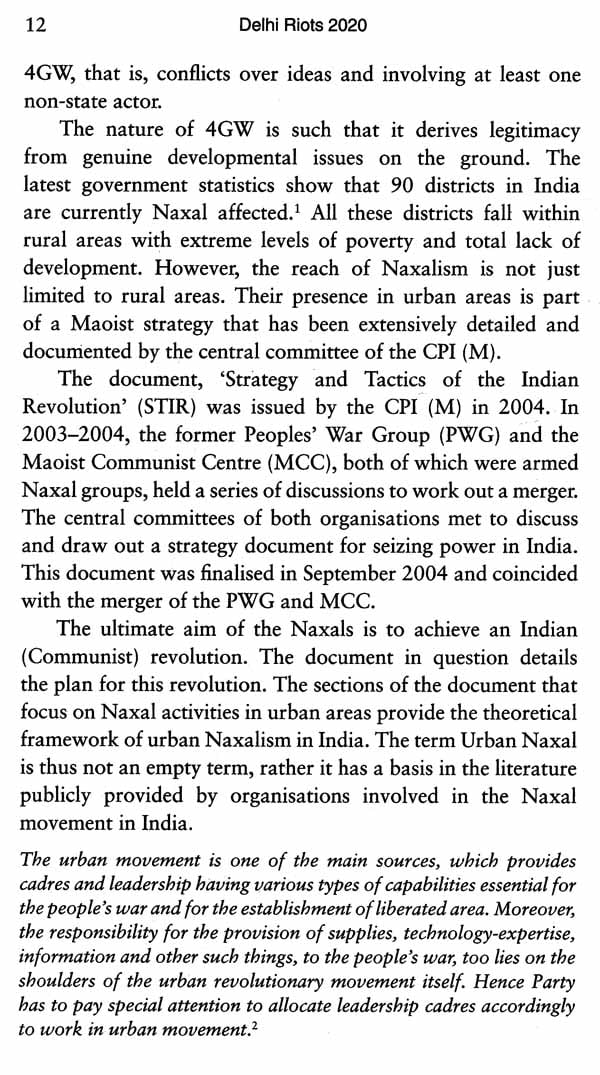
Delhi Riots 2020 - The Untold Story
Book Specification
| Item Code: | NAX511 |
| Author: | Monika Arora, Sonali Chitalkar & Prerna Malhotra |
| Publisher: | Garuda Prakashan Pvt. Ltd. |
| Language: | English |
| Edition: | 2020 |
| ISBN: | 9781942426295 |
| Pages: | 178 (Throughout B/W Illustrations) |
| Cover: | PAPERBACK |
| Other Details | 8.50 X 5.50 inch |
| Weight | 200 gm |
Book Description
On February 23 2020, North- East Delhi was engulfed by communal violence. The bloodbath that followed over the next three days left at least 53 people dead and scores of homes looted, shops and schools ransacked and burnt to the grounds.
The worst communal violence in India's capital in three decades was widely reported both by the Indian and global media. Numerous debates in newspapers and television talked about the violence, the role of the police and the government. Delhi Riots 2020: The Untold Story provides an explosive revelation of the plot behind the riots, how they were planned and executed, how weapons were procured and stockpiled, and exactly what happened. The book also takes a close look at the background to the carnage-CAA (The Citizen Amendment Act,2019), the unrest and violence in universities and the dharna at Shaheen Bagh and other sites in Delhi.
Monika Arora is a senior advocate in the Delhi High Court and the Supreme Court of India and the Convener of the Group of Intellectuals and Academicians (GIA). She is the standing counsel for Jawaharlal Nehru University and has represented JNU in important matters in court. She has been a counsel for various ministries including the Home ministry, Finance ministry, External affair ministry and the ministry of Human Resource and Development. She has fought thousands of cases in various courts. She is a powerful orator and has participated in various seminars/ awareness campaigns on Uniform Civil Code and ending discrimination against women. She has been fighting for women's right to equality, freedom and dignity.
Sonali Chitalkar is Assistant Professor, Department of Political Science at Miranda House, University of Delhi. Her area of Specialization is International Relations with a focus on Conflict Resolution. She has been working on the State of Jammu and Kashmir as a part of peace facilitation. She is currently working on the framework of an Indic Theory of Gender as a part of her interest in Decolonisation of the Indian mind and Indigenous Political Theory.
Dr. Prerna Malhotra teaches English at Ram Lal Anand College, Delhi University. She is the author of several books and is a prolific speaker and social influencer. She has worked extensively in Bastar and is a passionate voice for the rights of tribals of Bastar and against their brutalization by Urban Naxals.
As we bring forth this publication based on the ground report of the Delhi Riots early this year, which was a fact-finding mission undertaken by the Group of Intellectuals and Academicians (GIA) I am filled with a sense of having fulfilled our moral duty. After multiple visits to North East Delhi in the aftermath of the riots in February 2020, it was incumbent upon us to tell the world the true story of the agony faced by the 53 victims who lost their lives in this senseless violence. I am also aware that telling their story and that of the ordinary people who suffered economic losses and faced the naked terror on the streets of Delhi is necessary to cut through the rhetoric and propaganda associated with this episode of engineered communal violence. GIA watched with concern as Delhi burnt on 23-26 February 2020. However much before the immediate violence, members of the GIA discussed and worried over the deepening stress and tension that was being deliberately created in our beloved city over the Citizenship Amendment Act (CAA). Some of our members, who teach in various colleges in Delhi University (DU) and Jawaharlal Nehru University (JNU), noted the deliberate escalation of communal fault lines in Delhi at anti-CAA protest sites. We visited Shaheen Bagh to understand the happenings on the ground. And we came back appalled at the senseless dramatics being orchestrated by random groups there. We saw first-hand how theatrics and ideology, cloaked under the banner of the Tricolour and the Indian Constitution, barely hid a communal undertone. It was here that Kali, the free and fierce Hindu goddess, was imprisoned in a hijab. It was in Shaheen Bagh that Aum and the Swastika, holy to all Indic faiths, were desecrated.
As members of the public, we faced the circumstances created at protest sites, just like all the common citizens of this city were facing daily. We faced traffic jams due to the Shaheen Bagh blockage, at times Metro services were suddenly suspended due to disruptions by anti-CAA protesters. Getting home from work was a frustrating prospect. We saw how our democracy was rendered helpless by law enforcement and a legal system that was working to accommodate the right to protest. We witnessed the systematic blocking of arterial roads in Delhi at multiple locations. These blockages were designed to cut off populations and isolate potentially combustible areas of Delhi. We saw as crowds of protesters stormed the marketplaces in our vicinity and chose to stand in front of Hindu places of worship to raise azadi slogans. We felt the terror as protesters slammed the gates of our homes while raising slogans for the freedom of Kashmir. However, nothing prepared us for the violent hate unleashed on common citizens from the anti-CAA protest sites in North East Delhi.
GIA went to North East Delhi from 29 February 2020 onwards and made multiple visits to gather data till the submission of the report to the minister of state for home (MoS [Home]) Shri G. Kishan Reddy on 11 March 2020. We had held extensive interviews with victims, residents of these areas and law-enforcement personnel. We met religious leaders from both communities who worked to de-escalate the situation. The GIA ground report was an outcome of intense research and data gathering from violence-affected areas in North East Delhi.
I am thankful to Professor Vijita S. Aggarwal for her invaluable support in finalising this book. Divyansha Sharma has been a constant support for media and technical expertise.
I dedicate this book to all the victims of the Delhi riots in North East Delhi. Many young and promising lives were cut short by the bullets of hate that flew unrestrained in the area. Amongst the many victims were members of the Scheduled Caste communities who were brutalised in unimaginable ways. The weaker sections of society, like the nomads in Khajuri Khas, were also victims of the violence.
Nothing that we write or say can convey the depth of the tragedy of these riots. This book is an attempt to bring out the true story of the Delhi Riots. It is a call for remembering that communal fault lines were created between neighbours by ideologically vested interests comprising Urban Naxals and Jihadi elements who had an agenda to implement-to systematically conflagrate areas with mixed populations of Hindus and Muslims and take these areas from dharna to danga.
The insidious mindset of the Urban Naxals and Jihadis led to the creation and execution of the dharna-to-danga model in Delhi. This book is an attempt to tell the fact- and evidence-based story of this model that the GIA's fact-finding team gathered from North East Delhi.
Throughout history, colonizers have attacked the world's indigenous peoples and civilizations, and sought to erase and write over their culture and knowledge. The library of Alexandria at the temple at Serapeum in Egypt was burnt by Theophilus, the bishop of Alexandria, in a zeal to wipe out paganism. In the Spanish conquest of the Yucatan peninsula, thousands of Mayan codices were burnt by the Bishop Diego de Landa, claiming they were superstitions from the devil, eviscerating Mayan knowledge. Only four codices survived.
Successfully colonizing a people necessitates undermining their histories and knowledge and rewriting them to the colonizer's advantage. India was subject to colonization by two world-dominant religions. The Turkic-Mughal conquest burnt down universities, libraries and temples, all of which were sites of knowledge production and dissemination. The British conquest colonized by rewriting Indian histories and fabricating narratives and theories. Indigenous education and knowledge systems were destroyed and new ones, which suited the colonizer, were set up. These universities and institutions, and the intellectuals they produced and heralded, were established to perpetuate the colonial gaze. It is a long journey to undo this intellectual coloniality-institutional control of the narrative through production, publishing and distribution of knowledge remains.
At the same time, a host of Indians trained in these institutions continue to "interpret" India for the West, often at the behest of powerful global groupings. They retrofit India into ill-fitting European epistemes. For instance, "minority" in the US or Europe refers to non-White or non-Christian people who have been systemically disenfranchised in empirically demonstrable ways. In India, the term "minority" refers simply to the demographic minorities within the population, communities which belong to the two world-dominant religions which also colonized India, rather than coming from a history of systemic disenfranchisement. The intellectual dishonesty in conflating these two definitions of "minority" is glaring. These master narratives engage unethical conflations to misrepresent the continued violence in India of the globally dominant and well-resourced powerful groupings against the Hindu population they previously colonized.
Similarly, reference to the "Left" in India is not about some socialist center-Left policies. "Socialist" is part of the preamble of the Indian Constitution and all parties, including the so-called "right-wing" BJP, aver by it. The Indian Left are self-avowed Communist parties. Radical Left groups are responsible for more terrorism in India than any other ideological grouping. According to the Global Terrorism Index", "The deadliest group in India is the country's communist party-The Communist Party of India (Maoists). Maoists were responsible for 205 deaths and 190 terror incidents in India, or 53 per cent of deaths in 2017." These groups, also known as Naxals, have logistical support and intellectual covering fire from urban centers and universities, and these are termed Urban Naxals.
The top four global terror groups per the Global Terrorism Index are Islamic. A combination of Urban Naxals and Islamic radicalism is a deadly cocktail, as the events described in the book attest. These radical elements are not even amenable to intervention from Muslim clerics who are part of India's plural tapestry. According to the authors, Maulana Mohammad Daud Amini and Maulana Mohammad Shamim were themselves attacked and castigated as they appealed to the mob to abjure violence and clear the roads they were blocking.
This book was to be published by Bloomsbury India, a subsidiary of Bloomsbury UK, which had approved the content. Very close to the launch, Bloomsbury India pulled the book, apparently on orders of headquarters at Bloomsbury UK. This was egged on by a White male organizer of a major literary festival in India to shut down the voices of the three Indian women authors. A definitive act of colonial White privilege.
The authors turned to Garuda, a publishing house with an explicit aim of decolonization. Stars aligned and magic happened. Indians stood up to be counted. Within 24 hours of pre-launch, over 15,000 copies were pre-sold on the garudabooks.com website. People were hungry for authentic stories and tired of colonial gatekeepers determining who has permission to write, and what they get to read.
It was a sign of the emerging shoots of new India, one which will not be held back, though it is demonized via the academic and global narrative. It is a cry for a plural world where multiple viewpoints are given space rather than pre-judged and de-platformed by dominant forces. More perspectives on the tragic events in Delhi in 2019-2020 should be welcomed, as talking with each other rather than past each other, is the way forward for a plural society.
**Contents and Sample Pages**














